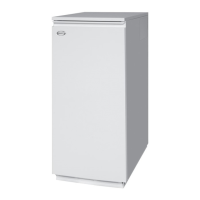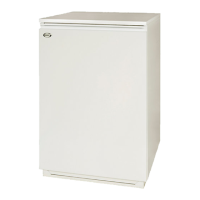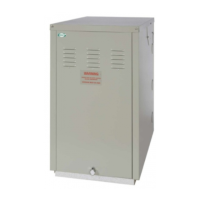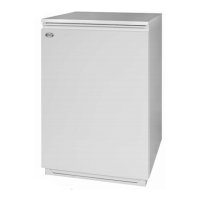Page 44 Section 11: Servicing
11.4 CLEANING THE BURNER:
RDB2.2 BX BURNERS ONLY
FOR 15-26 AND 26-46 MODELS
With the burner removed from the boiler:
Burner head, nozzle and diuser/electrode assembly:
1. Remove the burner head. Refer to Figure 10-5. Loosen the
three xing screws (1) and remove head (2) from burner.
2. Clean the burner head and recirculation tube (if tted).
3. Remove diuser/electrode assembly. Refer to Figure 10-5.
• Using a 4 mm Allen key, loosen the diuser xing screw
(3) from electrode assembly.
• Lift diuser/electrode assembly (5) up and o the nozzle
holder.
• Disconnect both ignition leads (4) from the electrodes.
4. Replace the nozzle (8). The nozzle should always be
replaced on an annual service. Refer to Table 2-2 for the
correct nozzle size and type for the required boiler output. Do
NOT attempt to clean the nozzle.
Use a 16 mm spanner to remove/re-t the nozzle, whilst
holding the nozzle holder using a 19 mm spanner.
! CAUTION !
The use of an ill-tting spanner will damage the nozzle
and could lead to an incorrect ame pattern and poor
combustion.
! NOTE !
Ensure that the nozzle is securely tightened so that it does
not leak but do not overtighten.
5. Inspect the ignition electrodes - remove the diuser xing
screw and withdraw the electrode assembly. Wipe clean and
check for any cracks in the ceramic insulation. Replace if
necessary.
6. Re-t the diuser/electrode assembly. Refer to Figure 10-5.
• Reconnect ignition leads (4) to electrodes.
• Re-t the diuser/electrode assembly (5) onto the nozzle
holder lining up the xing screw with the recess in the
nozzle holder.
• Ensure diuser assembly is tted down hard onto the
shoulder on the nozzle holder.
• Tighten the xing screw (3) to secure the diuser/
electrode assembly in place on the nozzle holder.
! NOTE !
Do not overtighten the xing screw as this may damage
the electrode insulator.
7. Check/adjust the electrode settings. Refer to Figure 10-6.
Always check the electrode settings after replacing the
nozzle.
8. Re-t the burner head. Refer to Figure 10-5.
• Locate the head xing screws (1) in the countersunk
slots in the burner collar.
• Check that the small oil drip hole (on the head) is
pointing downwards.
• Tighten the three screws (1) to secure the head (2) in
position on the burner.
9. Adjust the diuser position. Refer to Figure 10-7.
! NOTE !
The distance between the end of the burner head and the
front face of the diuser (D) MUST be correctly set for the
burner to operate correctly.
• Refer to Table 2-2 for the required distance (head
setting) for the boiler output required.
• Check the distance D using the gauge plate supplied
with the boiler.
• To use the gauge plate: Position the gauge on the
burner head as shown in Figure 10-7.
• Locate the gauge with the correct steps (i.e. the two
marked with the required distance D) resting on the
edge of the burner head.
• Check the gauge plate is at 90° to the end of the burner
head and is positioned at the full diameter of the head.
• If the distance D is correct, the tongue of the gauge
should just make contact with the diuser, with BOTH
steps still in contact with the edge of the burner head.
• If the steps are not in contact with the edge of the burner
head, when the tongue of the gauge is touching the
diuser, the diuser must be ‘opened’ (see below).
• If the tongue does not reach the diuser, when the steps
are in contact with the edge of the burner head, the
diuser must be ‘closed’ (see below).
To adjust the diuser position:
• If necessary, adjust distance D using the black
adjustment knob located around the oil supply pipe on
the front of the burner. Refer to Figure 10-7. Re-check
distance D using the gauge plate, as described above.
• For easier access to the adjustment knob, pull the
photocell out from the burner housing.
• To increase distance D (to open the diuser): rotate the
knob clockwise - indicated as ‘+’ on the knob.
• To decrease distance D (to close the diuser): rotate the
knob anti-clockwise - indicated as ‘-’ on the knob.
! NOTE !
One full rotation of the adjustment knob is approximately 1
mm of diuser movement.
! NOTE !
It is essential that the nal position of the diuser is
checked, using the gauge plate provided with the boiler
and the diuser adjusted as necessary to achieve the
required distance D.
10. Continue cleaning the other burner components as detailed
in Section 11.6
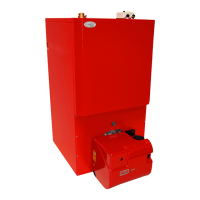
